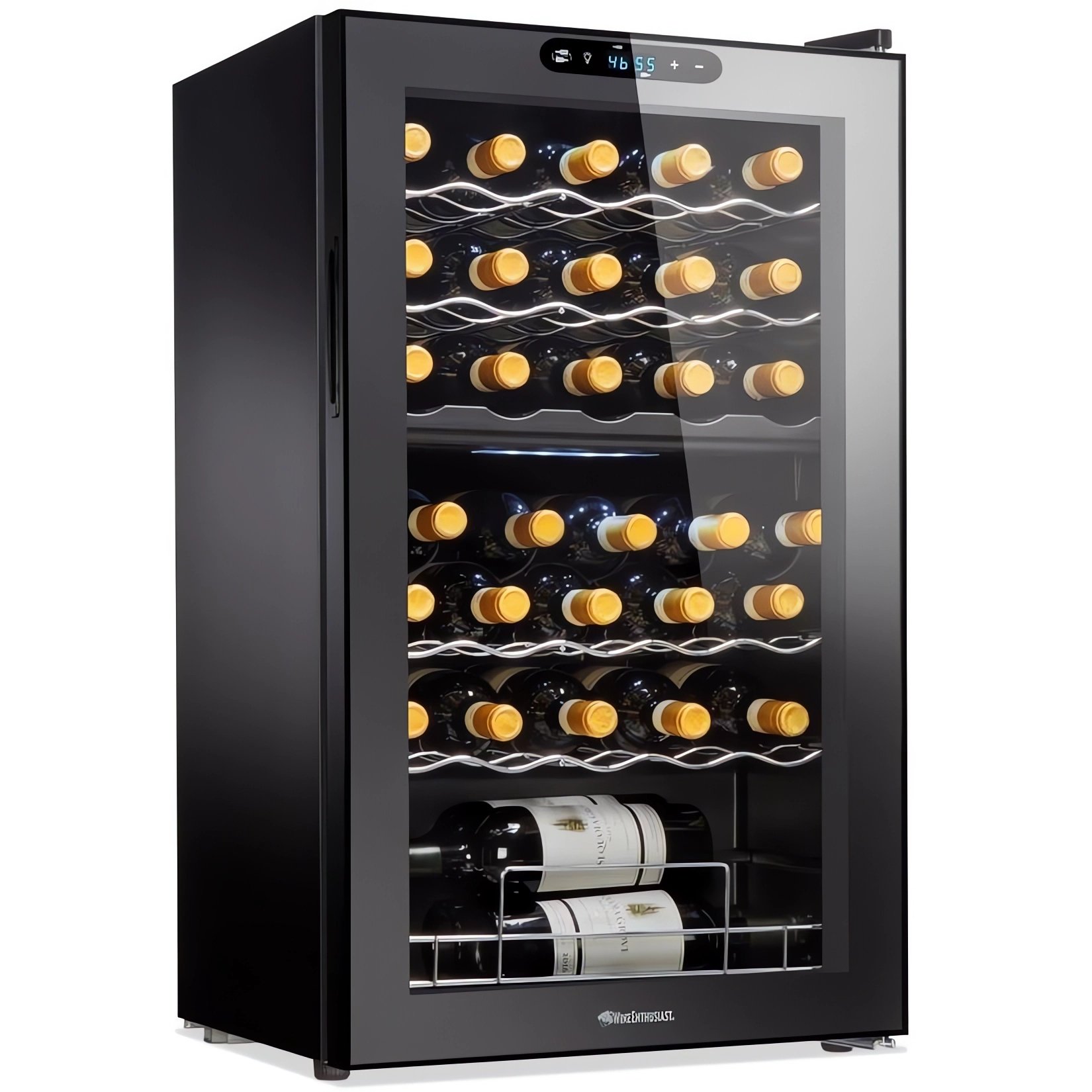Is a Wine Cooler Better than a Wine Refrigerator?
Wine Enthusiast Latitude
What’s the difference between a wine cooler and a wine refrigerator? It depends on who you ask. The terms are often used interchangeably, even by the pros. Both are refrigerated units that create controlled environments for your wine, but wine educator Sunny Gandara sets the record straight. “The wine refrigerator stores wines for long periods of time. The wine cooler chills the wines to the optimum drinking temperature.” Say it with us — wine refrigerators are for storing. Wine coolers are for serving.
What is a Wine Cooler?
Wine Enthusiast 32 bottle cooler
Wine coolers are small, often tucked away under counter height. Most accommodate two or three cases of wine maximum, and like their name suggests, keeps them cool. Wine coolers are set at standard refrigerator temperature, about 37°F, so your whites, rosés and sparkling wines can be brought down to ideal serving temperature, opened, then poured straight away. “It’s great for daily use, but not for long term storage,” explains Serena Lourie one of the founders of Cartograph Wines. For that, you want a wine refrigerator.
What is a Wine Fridge?
EuroCave La Premie photo credit Wine Enthusiast
Sometimes called a wine cellar, its larger format, accommodates more bottles — often hundreds more. Restaurants, resorts and wineries may have floor-to-ceiling wine refrigeration spanning an entire wall. They offer more than dramatic good looks. They preserve the life of the wine, and are usually set at about 55°F.
What's Best for You?
From there, all bets are off. There are wine coolers and refrigerators to suit every style, size, and budget. How can you determine which one’s best for your needs and your home? Experts agree on a few points:
Capacity
Or bigger really is better. “I would start by being honest about how many bottles or cases you plan to assemble,” says Jesse Salazar wine director at Pebble Beach Resorts’ Stave, "Then double it. You’ll probably fill it up more rapidly than you think,” agrees Food and Wine’s Executive Wine Editor, Ray Isle. “Wine storage is like computer memory — you'll always end up needing more than you thought you did.”
Shelving
Not all wine bottles are created equal. Pinot noir and champagne bottles have broader bases than longer, slender riesling bottles. When possible, view wine cooler and cellar models onsite at a showroom rather than online. Check out the shelving’s durability, balance, and action, and, advises Isle, author of The World in a Wineglass, bring a bottle of pinot with you. "See if the thing actually fits without getting its label ripped off in the process.”
“Somehow every company has managed to create shelves so close together that the majority of wines will get jammed or have the labels ruined,” says Melissa Smith, founder of Enotrias Elite Sommelier Services. “And I cannot emphasize this enough, stay away from units with shelves that pull out. At some point, they fail.”
Light
“Sunlight is good for grapes, but very bad for wine,” says Salazar. “Treat your wines like produce or dairy and keep them cool and dark.” While having an undercounter wine cooler in the kitchen makes for convenience, be sure you situate it away from direct sunlight. That’s why Salazar gives the edge to storing a cooler in a closet, away from light. “Light control is important,” agrees Lourie “We had a wine refrigerator in the garage once — I don’t advise it — and we had to put a screen in front to prevent light from hitting it.”
Temperature
Some models and brands boast dual zoned units, with two independent temperature controlled areas. Pros are split on the value they offer.
Isle finds it “Pretty convenient to have a dual temp zone fridge. You want your white and reds at different temperatures.” On the other hand, “I keep all my wines at the same temperature,” says Ronnie Sanders, CEO of Vine Street Imports. Unless you entertain big groups frequently, Enotrias’ Smith thinks dual temperature units for home use aren’t necessary. “You can chill a bottle in an ice bucket in 10 minutes. Cheaper and reliable.”
For Gandara, dual temperature “is just more bells and whistles.” The more bells and whistles and moving parts the unit has, the more variables and risks. “Reliability is key,” adds Isle. The real issue is keeping the unit temperature consistent. Opening and closing the unit a dozen times a day causes fluctuations in temperature. Wine wants to be left in peace. “Be anal,” says Gandara. “You need steady temperature to store fine wine.” “Temperature stability is the most important factor,” agrees Lourie. “If the wine is exposed to multiple up and down temps, it will age faster."
Budget
Sub-Zero wine fridge photo credit Sub-Zero
Brace yourself. Wine coolers and refrigerators skew wildly in price.
Compare entry-level free-standing hundred-bottle wine refrigerator prices: Wine Enthusiast branded wine refrigerators are generally well-rated and start at $2,000. From there it goes up. Way up. High-end brands include Vinotemp with models that cost up to $7000 for a 141 bottle until, and Gandara’s dream brand, EuroCave (pronounced yuro-cahhhve, darling) unit goes for $4,500.
Le Cache
Smith says “Le Cache all the way,” at $5,395. Sub-Zero's 30 inch built in column wine storage unit, doubles that at $10,435. Whenever built-in or custom cabinetry is involved, add a few thousand dollars and a few months for delivery and installation.
Wine coolers and refrigerators are pricey no matter which unit you choose, but Salazar puts it this way: “The money you’ll spend on a reliable wine cooler is a fraction of what you’ll spend on wine over the course of your cooler’s lifetime.”





